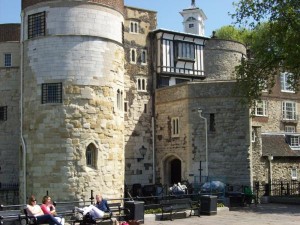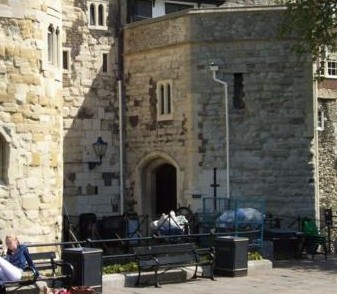
After the bloodshed of the past couple of weeks it’s nice to write about a happy event from Anne Boleyn’s life, her coronation. This is what Anne and Henry had been aiming for all those years, this was the icing on the cake and the opportunity for Henry VIII to show London that Anne Boleyn was his wife and the rightful Queen.
The four days of pageantry and celebration, which the Milanese ambassador estimated at costing the City of London around £46,000 and Henry half that again, was a clear message from the King to his people, the Court and the rest of Europe: Anne Boleyn is my Queen, forget Catherine.
The Procession
The 29th May 1533 was the first day of the coronation celebrations and Eric Ives gives a wonderful rundown of the day in his book “The Life and Death of Anne Boleyn”. He writes of how at 1pm the London livery companies’ fifty barges set out from Billingsgate accompanied by an escort of smaller vessels.
These “barges” were not barges as we think of today, they “were sixty or seventy feet long with a beam of ten feet or so, shallow draft and a large covered cabin for passengers. They were powered by four to eight oars a side up forrard and were highly decorated”1. Ives describes their appearance that day:-
“On that Thursday they were more elaborately dressed than even for the lord mayor’s procession, with flags and bunting overall, hung with gold foil that glistened in the sun and with little bells that tinkled; the vessels were packed with musicians of every kind, and more cannon than seems safe on such a crowded waterway. The fleet was led by a light wherry in which had been constructed a mechanical dragon that could be made to move and belch out flames, and with it were other models of monsters and huge wild men, who threw blazing fireworks and uttered hideous cries.”2
Wow, what a spectacle for the crowds lining the Thames! What splendour! But there was more! Behind these barges came the mayor’s barge with the scarlet robed aldermen and the bachelors’ barge which was dressed with gold and silver cloth, flags, streamers with bells on, two huge banners decorated with the arms of Henry and Anne, and thirty six shields, and which carried “trumpets and divers other melodious instruments”3 – wow! But again, that’s not all! A wherry on the opposite side of the mayor’s barge carried a huge representation of Anne Boleyn’s badge: the crowned white falcon perched on a gold tree stump, which had red and white roses bursting out of it, with a green hill in the background surrounded by “virgins singing and playing sweetly”4.
Due to the fact that they were all rowing against the tide (how tiring!), it took the procession two hours to get from Billingsgate to Greenwich where, according to Ives5, it had to reverse its order and then anchor at the palace steps to await the Queen. At the palace, Anne boarded her barge, her ladies boarded a second one and the King’s guard boarded the King’s barge, the King was not part of the procession. These three barges were joined by the barges of the courtiers and Eric Ives writes of how there were “some 120 large craft and 200 small ones”6, all lavishly decorated. There is a wonderful description of this procession in the Letters and Papers, Foreign and Domestic, Henry VIII, Volume 6 (LP vi.563):-
“the banars and penanntes of armis of their craftes, the which were beaten of fyne gould, yllastring so goodly agaynste the sonne, and allso the standardes, stremares of the conisaunsys and devisis ventylyng with the wynd, allso the trompettes blowyng, shallmes and mistrielles playng, the which war a ryght symtivis and a tryhumfantt syght to se and to heare all the way as they paste upon the water, to her the sayd marvelles swett armone of the sayd ynstermentes, the which soundes to be a thinge of a nother world.”7
which translated into modern English is:-
“the banners and pennants of the arms of their crafts, the which were beaten of fine gold, reflecting so goodly against the sun, and also the standards, streamers of the cognisances and devices waving in the wind, also the trumpets blowing, shawms and minstrels playing, the which were a right sumptuous and a triumphant sight to see and to hear all the way as they passed upon the water, to hear the said marvellous sweet harmony of the said instruments, the which sounds to be a thing of another world.”8
Wouldn’t you just love to go back in time and relive this happy moment, a moment which must have meant so much to Anne.
Letters and Papers describes of how gun salutes heralded the Queen as she made her way along the Thames and that “when she came over against Wapping mills the Tower “lousyd their ordinaunce” most triumphantly, shooting four guns at once.”9 How wonderful.
The Entry into the Tower
Letters and Papers records Anne Boleyn’s triumphant entry into the Tower of London:-
“At her landing, a long lane was made among the people to the King’s bridge at the entrance of the Tower. She was received on coming out of her barge by Sir Edw. Walsingham, lieutenant of the Tower, and Sir Will. Kinston, constable of the Tower. The officers of arms gave their attendance ; viz., Sir Thos. Writhe, Garter king-of-arms, Clarencieux and Norroy kings-of-arms, Carlisle, Richmond, Windsor, Lancaster, York, and Chester heralds ; the old duchess of Norfolk bearing her train ; the lord Borworth (sic), chamberlain to her Grace, supporting it, &c. A little further on she was received by lord Sandes, the King’s chamberlain, lord Hause (Hussey), chamberlain with the Princess, the lord Windsor, the lord Nordunt (Mordaunt?), and others ; afterwards by the bishops of Winchester and London, the earl of Oxford, chamberlain of England, lord Will. Haworth, marshal of England, as deputy to his brother Thos. duke of Norfolk, the earl of Essex, &c.
Somewhat within the Tower she was received by the King, who laid his hands on both her sides, kissing her with great reverence and a joyful countenance, and led her to her chamber, the officers of arms going before. After which every man went to his lodging, except certain noblemen and officers in waiting. The King and Queen went to supper, and “after super ther was sumptuus void.””10

Queen Anne Boleyn entered the Tower of London by the same entrance that she would use just under three years later when she was arrested, how ironic. This time she was being heralded as the new queen and received by an overjoyed King who greeted her with their first public kiss.
On our recent trip to the Tower of London, we saw this gate and were disappointed that, instead of having a plaque telling of Anne’s entrance into the Tower and her first public kiss with Henry, it was sadly neglected, having rubbish bags piled up against it. This is the Court Gate of the Byward Tower (see the arched doorway in the photo) which allowed kings and queens to enter the Tower privately from Tower Wharf. We can only imagine Henry VIII’s pride, as he kissed his pregnant queen, and Anne’s intense happiness and relief. From there, Anne and Henry would have entered the Royal Palace to enjoy a night together.
Sources
- The Life and Death of Anne Boleyn, Eric Ives, p173
- Ibid.
- Ibid.
- Ibid.
- Ibid.
- Ibid.
- LP vi.563
- The Life and Death of Anne Boleyn, Eric Ives, p174
- LP vi.563
- Ibid.
May was an important month in Anne’s life, for good and for bad reasons.. This must have been the moment of her triumph and glory!
I know it costs a lot to keep buildings in good shape but this entrance is an important part of history! It’s time to clean up this spot and give it the dignity that it deserves. I know we all have to take out the trash, but why there? I’ll get off my soapbox now.
I didn’t know that she was crowned on the 29th. Isn’t that strange in a way – her coronation and exection were (3 years and) 10 days apart?
Sorry for rambling. Great article!
Cameras were invented FAR too late in human history. Can you imagine the DAZZLING photos from this event? All descriptions of Anne sound breathtaking, not only from what she wore, but also the woman herself.
Miladyblue, I agree…there are many, many people and events in history I wish we could see actual photos (and film) of ….
Beware of photographs! Even in the early days of photography, events were staged – if you have seen photos of the American Civil War, many of them are not candid photos but rearranged for a more gruesome show. I guess that’s why photography is part of art history. Even the development of film can be subjective and show something to be different than you would see in real life. One of the first things an art history teacher told my class was that photos lie – a tiny object can look huge and a big one look small. I think that was too much information – sorry about that!
Miladyblue and Matterhorn, I totally agree!
It makes me smile to think of Anne in such a state; with her man, her throne, and hopefully her future son. – But then, it also makes you wonder how Henry could murder the woman he had lavished in anyway possible under 3 years later.
I know! He spent a small (or rather) large fortune on her coronation and a lot of time and effort making her his wife and queen! Weird.
Lisaannejane,
You are absolutely right! Not only can photos be staged and reaaranged, but portraits themselves are not reliable, either. One thing that bothers me about the present group of historians writing about Anne, is how often they take the auburn hair in her portraits at face value. Fair hair was more valued and fashionable back then and it is natural to think that when Anne was high in the King’s esteem, she (or he) might have wanted to be portrayed in the best fashionable, and favorable light. I always go with written descriptions as being more reliable than portraits. It is certainly true that Anne would likely have said to the photographer, “No, not my left side. My right side is better!” or some such thing. 🙂